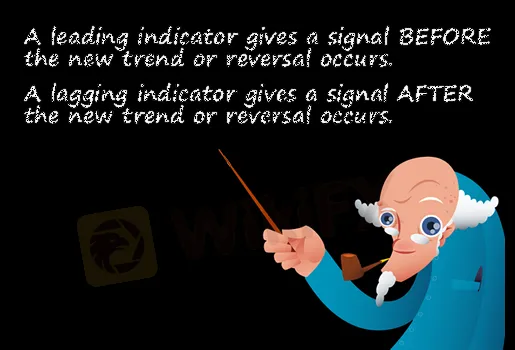Forex is a game that I enjoy playing
These champions have one thing in common: they not only work their butts off, but they also enjoy what they do.
简体中文
繁體中文
English
Pусский
日本語
ภาษาไทย
Tiếng Việt
Bahasa Indonesia
Español
हिन्दी
Filippiiniläinen
Français
Deutsch
Português
Türkçe
한국어
العربية
Abstract:We've gone over the two types of technical indicators based on when the signals are generated. Leading and lagging indicators are the two sorts of indicators.
Technical indicators are used by many forex traders as part of their technical analysis toolkit.
We've gone over the two types of technical indicators based on when the signals are generated.
Here's a quick rundown of what we talked about in the previous lessons:
Leading and lagging indicators are the two sorts of indicators.
A leading indicator or oscillator sends out a signal before the start of a new trend or reversal.
A lagging indicator, often known as a trend-following indicator, sends out a signal after the trend has begun.
Indicators that are ahead of the curve
Oscillators are commonly used as leading indicators.
They're called leading indicators because they present you a heads-up on a probable trend reversal before it happens.
Leading indicators have the advantage of alerting you to a probable reversal early.
Oscillators have the problem of producing a lot of erroneous signals.
Leading indicators are ineffective as stand-alone tools. Leading indicators should be used in conjunction with other tools like Japanese candlestick patterns, classic chart patterns, and support and resistance.
If you can figure out what kind of market you're trading in, you'll be able to figure out which indications are useful and which ones you should ignore.
The Stochastic, the Relative Strength Index (RSI), Williams percent R, and the Momentum indicator are all popular leading indicators.
Indicators that are late to the game
Trend-following or trend-confirming indicators are examples of lagging indicators.
The lagging indicators' trading signals arrive after the event has occurred on the chart.
Lagging indicators have the disadvantage of putting you in the trade late. This means you'll usually miss a significant portion of the price movement.
Moving Averages (Simple, Exponential, Weighted), Parabolic SAR, and Moving Average Convergence Divergence are all popular lagging indicators (MACD).
So, how do you know when to employ oscillators, trend-following indicators, or a combination of the two?
That's a million-dollar question all over again! After all, we all know they don't always get along.
We'll pay you a million dollars as soon as possible...
Oh, no! We were referring to the million-dollar response!
For now, simply remember that once you've determined the type of market you're trading in, you'll be able to determine which indicators will provide reliable signals and which will be useless at the time.
This isn't going to be easy.
It is, however, a skill that you will gradually improve as your experience grows.
In the following parts, we'll show you how to correctly identify the forex market environment you're trading in and how to use these indicators more effectively!

Disclaimer:
The views in this article only represent the author's personal views, and do not constitute investment advice on this platform. This platform does not guarantee the accuracy, completeness and timeliness of the information in the article, and will not be liable for any loss caused by the use of or reliance on the information in the article.

These champions have one thing in common: they not only work their butts off, but they also enjoy what they do.

"Patience is the key to everything," American comic Arnold H. Glasgow once quipped. The chicken is gotten by hatching the egg rather than crushing it."

Ask any Wall Street quant (the highly nerdy math and physics PhDs who build complicated algorithmic trading techniques) why there isn't a "holy grail" indicator, approach, or system that generates revenues on a regular basis.

We've designed the School of WikiFX as simple and enjoyable as possible to help you learn and comprehend the fundamental tools and best practices used by forex traders all over the world, but keep in mind that a tool or strategy is only as good as the person who uses it.
